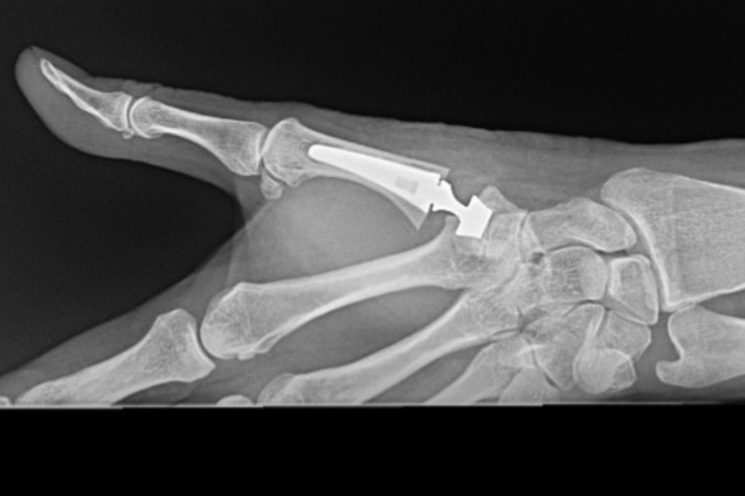
What is a hip replacement?
A hip replacement (hip arthroplasty) is a surgical procedure that involves replacing a damaged or diseased hip joint with an artificial prosthetic implant. This type of surgery is used to alleviate pain, enhance mobility, and improve quality of life in people experiencing conditions such as arthritis or pain and stiffness following damage to the hip joint. A total hip replacement can last up to 15 years.
During total hip replacement surgery, the ball of the hip joint (the top end of the thigh bone, which is usually on a stem that goes into the femoral bone) and the socket (the connected section of hip in your pelvis) are replaced with artificial materials such as metal, plastic, or ceramic. These prosthetic components are designed to replicate the functions of a healthy hip joint, allowing for smooth movement and weight-bearing capabilities.
There are different types of hip replacements, depending on the extent of damage to your hip joint. A total hip replacement involves replacing both the ball joint and the socket, whereas a partial hip replacement only addresses the ball joint and leaves the socket intact.
You may be recommended hip replacement surgery if other treatments – such as medication, physical therapy, or lifestyle adjustments – are no longer providing relief from hip pain or decreased mobility. An orthopaedic surgeon will be able to determine your eligibility for a hip replacement after evaluating your condition, medical history, and individual circumstances.
How do you know if you need a hip replacement?
To determine if you may need a hip replacement, several signs and symptoms should be considered. These include:
- Persistent pain in and around the hip joint – This is commonly felt in the groin and the outside of the hip. Rarely, some people may experience this pain further afield in the thigh, back, or knee. Your pain is also likely to worsen when active. Sometimes, hip pain may be referred from sources outside the hip, such as the spine or pelvis – your surgeon will be able to diagnose the true cause of your symptoms.
- Existing hip arthritis – Osteoarthritis is a degenerative condition that occurs when the cartilage that cushions and protects the ends of the bones wears down over time, causing severe pain and stiffness.
- Reduced mobility – You may notice that exercising is more difficult, or you are having trouble with household tasks like gardening.
- Increasing pain or decreased mobility following a previous hip injury – You may need a hip replacement if you have ongoing symptoms following trauma to the hip.
If you are experiencing these symptoms, you should book a consultation with an orthopaedic consultant who will be able to determine whether a hip replacement is the best treatment for your condition. Individual factors such as age, overall health, and the impact of your condition on your quality of life will also influence this decision and choice of implants.
Which method of hip replacement is best?
The best method of hip replacement for your individual circumstances depends on factors such as your age, your activity level, and how much your condition is affecting your quality of life. There are different types of hip replacement, including total hip replacement, partial hip replacement, and hip resurfacing.
Total hip replacement is the most common type of hip replacement and is often used in older people with arthritis. The two components that are replaced are the ball of the hip joint and the socket. The ball of the hip joint (the femoral head) is located at the top of the thigh bone (femur), while the socket (acetabulum) is the part that surrounds the femoral head and allows for movement. In total hip replacement, the ball of the hip joint and socket are replaced with metal, ceramic, or plastic parts.
A partial hip replacement involves replacing the ball of the hip joint with an artificial component and leaving the socket intact. It is usually only used in patients who have fractured or injured the ball of the hip joint.
Hip resurfacing involves replacing the socket and reshaping the ball of the hip joint so that a metal cap can be placed on top of it. It is primarily intended as a treatment for
younger male patients, particularly where stability is of concern due to their planned activities. Although less bone is resected to perform the procedure, it requires more muscle release. Hip resurfacing can be revised into a total hip replacement at a later date.
How long does a hip replacement take?
Hip replacement surgery takes between one to two hours to complete.
You will usually have a general anaesthetic, where you’re asleep, or a spinal anaesthetic, where you're awake but have no feeling below the waist. If you prefer to be asleep whilst the procedure takes place, then you can discuss this with your surgeon.
Your surgeon may use a minimally invasive approach for your surgery, which means that they will make smaller incisions.
For total hip replacement, your surgeon will make an incision (or several incisions) in the back or side of your hip so that the damaged hip joint can be taken apart. The ball-shaped end of the thigh bone (the femoral head) is removed, and a prosthetic stem with a ball is attached. The hip socket is then reamed out and replaced with a prosthetic socket (which may have an inner liner), before fitting the hip back together and closing the incisions.
How long is recovery from a hip replacement?
You can usually return home from hospital after one to three days, provided you are recovering well. Throughout your recovery, you will be supported by a physiotherapist and occupational therapist who will provide you with exercises to aid you in regaining strength and mobility.
It typically takes about six to 12 weeks for most patients to return to normal activities, although complete recovery can take up to a year. Your recovery time will also vary based on factors such as age, overall health, severity and duration of disease prior to
surgery, and adherence to post-operative exercises.
How much does a hip replacement cost?
If you’re looking to pay privately for a hip replacement, our dedicated Self-Pay team will be able to provide you with personalised advice and support – from walking you through our flexible payment plans to helping you choose the right consultant. There’s no obligation to book an appointment when you call us, and we’d be happy to answer any questions you might have.
We provide two types of self-pay packages for hip replacement surgery:
- A hospital package that groups standard diagnostics and the procedure into one clear price. Consultant fees, anaesthetist fees, and any other addition to your treatment are billed separately.
- A fixed price package that groups everything you may need for treatment into one clear price, including pre-admission tests, the procedure, professional fees, post-op outpatient care, and any other consultant-recommended services.
To find out the latest prices for hip replacement surgery at Cromwell Hospital, please visit our dedicated page.
We also welcome patients with private health insurance or embassy sponsorship.


